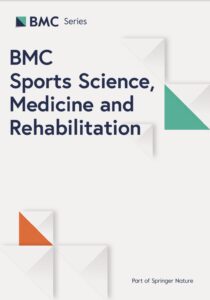Publications

Forearm rotation and elbow angle differentially modulate biceps brachii and brachioradialis muscle stiffness and EMG activity during low‑load isometric contractions: a cross‑sectional study in healthy individuals
Authors: Yiming Chen 1, Shujuan Huang 1, Peifeng Shen 1, Yuanchao Li 1, Yanan He 1, Guotong Dong 1, Siqi Huang 1, Meixia Zou 1, Zhijie Zhang 2, and Chunlong Liu 1
Affiliations:
- Clinical Medical College of Acupuncture Moxibustion and Rehabilitation, Guangzhou University of Chinese Medicine, Guangzhou, China
- Luoyang Orthopedic Hospital of Henan Province, Orthopedic Hospital of Henan Province, Luoyang, China
Journal: BMC Sports Science, Medicine and Rehabilitation - July 2025, Volume 17, Article no. 174 (DOI: 10.1186/s13102-025-01226-y)
-
Field & Applications:
- Methodology
- Normatives
Background: With increasing occupational demands for flexed elbow postures, understanding multi-joint influences on upper limb musculature becomes crucial. This cross-sectional observational study investigated the effects of forearm rotation and elbow flexion angles on muscle stiffness and activation patterns in biceps brachii (BB) and brachioradialis (BR) during loaded isometric contractions.
Methods: Thirty-six healthy males performed isometric elbow flexion under 15 combinations of isometric elbow flexion (3 forearm rotational state × 5 elbow joint angles). Muscle stiffness was quantified using MyotonPRO, while activation levels were assessed via surface electromyography (sEMG).
Results: Elbow angle and forearm rotation exerted significant main effects on BB stiffness and sEMG RMS (p ≤ 0.05). Their interaction influenced BB stiffness (p ≤ 0.05) but not RMS. In pronation, BB stiffness progressively decreased from 15° (resting) to 120°, with significant reductions at 15° vs. 90°/120° and 30°-60° vs. 90°/120° (p ≤ 0.05). Neutral/supinated positions exhibited peak stiffness at 60°. Under 1 kg loading, stiffness ranked: pronation (lowest) < neutral < supination (highest; p ≤ 0.05). BB RMS peaked at 60° (neutral/supination) and 45° (pronation). Pronated BB RMS was reduced at 30° vs. 45°/60°/120°, while neutral positioning showed lower RMS at 30° vs. 45°-120° (p ≤ 0.05). Supinated BB RMS decreased at 30° vs. 45°/60° and 120° vs. 45°-90° (p ≤ 0.05). Among 30°-90°, supinated BB RMS exceeded neutral/pronated values; neutral surpassed pronation. At 120°, pronated RMS remained lower than neutral/supinated (p ≤ 0.05).
For BR, elbow angle affected both stiffness and RMS (p ≤ 0.05), while forearm rotation influenced only RMS (p ≤ 0.05). Interaction effects occurred for both parameters (p ≤ 0.05). BR stiffness declined progressively from 30° to 120°. Pronated BR stiffness was elevated at 30° vs. 60°-120°, 45° vs. 90°/120°, 60° vs. 90°/120°, and 90° vs. 120° (p ≤ 0.05). This progressive pattern was consistent across neutral and supinated positions. Supination yielded higher resting (15°) BR stiffness than pronation/neutral (p ≤ 0.05). Loaded BR stiffness at 45° was greater in pronation vs. supination (p ≤ 0.05). BR RMS peaked at 60° (pronation/neutral) and increased progressively from 30° to 120° (supination). Pronated BR RMS was reduced at 30° vs. 45°-120°, while supinated positioning showed lower RMS at 30° vs. 60°-120°, 45° vs. 90°/120° and 60° vs. 120° (p ≤ 0.05). Neutral RMS was reduced at 30° vs. 60°, increased at 45° vs. 120° and 60° vs. 90°/120° (p ≤ 0.05). Across positions, supinated BR RMS was reduced at 30°-60° vs. pronated/neutral, while pronation demonstrated higher RMS at 90°/120° vs. neutral/supinated (p ≤ 0.05).
Conclusions: These findings suggest that during a 1 kg-loaded isometric elbow flexion task, both muscles exhibit differential activation patterns in response to forearm rotation, elbow joint angle, and their interaction. The observed variations in sEMG RMS values may reflect distinct activation strategies, with BB appearing more active in supination and BR in pronation. Further controlled studies are needed to clarify the underlying biomechanical mechanisms.
Keywords: elbow joint, forearm, upper extremity, muscles, surface electromyography, isometric contraction
The current study evaluated how the stiffness and activation of the dominant elbow flexors in healthy young male participants were influenced by forearm rotation status and elbow flexion angle when performing isometric elbow flexion with a 1 kg load. Our findings demonstrate that both BB and BR exhibited distinct activation patterns characterized by differential responses to forearm rotation, elbow joint angle variations, and their biomechanical interactions. The observed variations in sEMG RMS values suggest muscle-specific activation strategies, with BB demonstrating more active in supination and BR showing increased activation in pronation. These results provide support for refining the biomechanical parameters in upper limb musculoskeletal modeling, while establishing a baseline reference for potential disease diagnosis and treatment.


